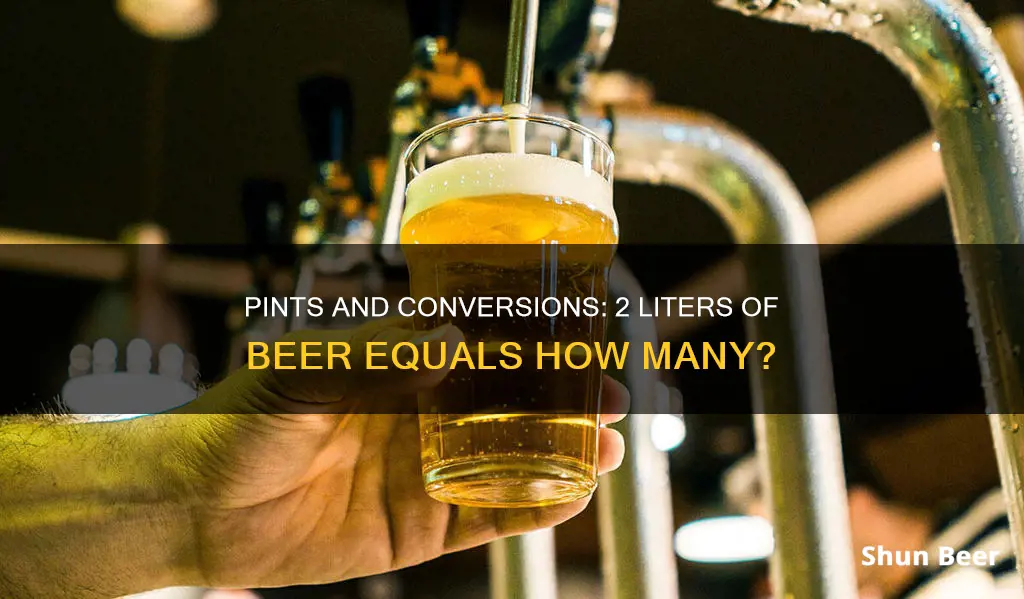
When it comes to beer, the pint is more than just a measurement. It's an iconic unit of volume that evokes a sense of camaraderie and enjoyment for many Brits and Irish alike. While the exact volume of a pint may be unknown to most, it's essential to understand the conversion between pints and litres, especially when dealing with larger quantities like kegs. In the UK, the ability to convert between metric and imperial units is crucial, as both systems are commonly used in everyday conversations about capacity. So, how many pints are there in 2 litres of beer? Let's find out!
| Characteristics | Values |
|---|---|
| Number of pints in 2 litres of beer | 3.5 pints or 7 half pints |
| Number of pints in 1 litre of beer | 1.8 pints |
| Number of pints in 1 litre of beer (US) | 2.113376419 pints |
| Number of pints in 1 litre of beer (UK) | 1.759753986 Imperial pints |
| Number of pints in 1 pint (US) | 16 ounces |
| Number of pints in 1 pint (UK) | 20 ounces |
What You'll Learn

There are 3.5 pints in 2 litres
When it comes to beer, understanding the volume and measurements is essential, especially when serving and enjoying your favourite brew. There are 3.5 pints in 2 litres, and this knowledge can help you make informed choices about your beverage.
To break it down, let's first look at what a pint and a litre are. The pint is a standard unit of volume in the imperial and United States customary measurement systems. In the US, a liquid pint is approximately 473 mL, while the British imperial pint, used in the UK and Ireland, is about 20% larger, at 568 mL. The litre, on the other hand, is a metric system unit of volume, defined as the volume of a 10 cm x 10 cm x 10 cm cube.
Now, when it comes to converting litres to pints, the calculation differs depending on whether you're using the UK imperial or US customary measurements. For US customary measurements, 1 litre is equal to 2.113376419 pints, while for UK imperial measurements, 1 litre is equal to 1.759753986 pints. So, when you have 2 litres, you multiply it by the conversion ratio for pints.
By understanding the conversion ratios and calculations, you can make sure you're getting the right amount of beer for your money. It's also helpful when purchasing kegs or when travelling to different parts of the world, as pint sizes can vary from country to country. So, the next time you're at the pub or enjoying a beer at home, keep in mind the number of pints in 2 litres and raise a glass to your newfound knowledge!
Oklahoma Beer: Unique Taste or Marketing Ploy?
You may want to see also

The conversion rate is 2.113375 pints/litre
When it comes to beer, understanding the conversion rate between litres and pints is essential. The conversion rate is 2.113375 pints/litre, and this knowledge can be incredibly useful when purchasing or serving beer.
In the world of beer, the pint is a standard unit of measurement. In the United States, a pint typically contains 16 ounces or 473 millilitres, while the imperial pint, used in the United Kingdom and Ireland, is slightly smaller at 20 fluid ounces or 568 millilitres. This distinction is important, as the British imperial pint is about 20% larger than its American counterpart.
When it comes to litres, it is defined as the volume of a cube that is 10 centimetres on each side. This definition is part of the metric system, which almost all countries besides the United States have standardised.
With the conversion rate of 2.113375 pints/litre, we can easily determine how many pints are in a given volume of beer. For example, a 2-litre keg contains 3.5 pints or 7 half pints, while a 5-litre keg offers 8.80 pints, making it perfect for parties or larger gatherings.
It is worth noting that the conversion rate remains consistent regardless of the type of beer. Whether it's a lager, ale, or craft beer, the volume measurements will be the same, providing a straightforward way to calculate the number of pints in a given amount of beer.
Oktoberfest Beers: What Sets Them Apart?
You may want to see also

The British imperial pint is 20% larger than the US pint
There are 2.113375 pints in a litre, or 2.1 pints to the nearest decimal place. This means that 2 litres of beer contain approximately 4.2 pints.
The difference between the two measurements dates back to 1824 when the British parliament replaced the various gallons with a new imperial gallon based on the volume of 10 pounds of distilled water at 16.667°C (277.42 cubic inches). This change did not affect the US, which continued to use the British wine gallon of 231 cubic inches as its basic liquid measure. As a result, the US liquid pint is derived from a different gallon measurement than the British imperial pint, leading to the 20% difference in volume.
The British imperial pint is used in the United Kingdom and Ireland and, to a lesser extent, in some Commonwealth nations. In the US, two types of pints are used: a liquid pint and a less common dry pint. The liquid pint is the standard size glass for beer, with a conical shape and a capacity of 16 fluid ounces.
The pint is a unit of volume or capacity in both the imperial and US customary measurement systems. It is traditionally equal to one-eighth of a gallon in both systems. However, due to the different definitions of the gallon in the two systems, the actual volume of a pint varies.
Beers Around the World: A Guide to Varieties
You may want to see also

1 US pint = 16 fluid ounces
There are 2.113375 pints in a litre of beer. This means that there are approximately 2.1 pints in a litre, or 2 litres in 4.2 pints.
Now, a US pint is equal to 16 fluid ounces. This is different from the UK Imperial pint, which is equal to 20 fluid ounces. This is because the British pint is 20% larger than the American pint. So, when ordering a pint in the UK or Ireland, you will be getting 20 fluid ounces, whereas in the US, a pint will be 16 fluid ounces.
The term "pint" comes from the French word "pinte", which likely originated from the Latin term "pincta", derived from the painted marks on the side of a container to indicate its capacity. In ancient Rome, a pint was 1/8 of a gallon!
The fluid ounce is a unit of volume that is equal to 1/16th of an Imperial pint and weighs 1/16 of a pound, or 28.3 grams. In the US system of measurement, a liquid pint has 16 fluid ounces, while in the UK, or using the Imperial system, a pint has 20 fluid ounces.
To convert litres to pints, you can use the following formula:
Pints = litres x 2.113375
So, for example, to convert 5 litres to pints, you would do the following calculation:
Pints = (5 litres x 2.113375) = 10.566875 pints
Chelada vs. Red Beer: Understanding the Differences
You may want to see also

1 UK imperial pint = 0.56826125 litres
The British Imperial pint is defined as one-eighth of an Imperial gallon. The Imperial gallon was defined in 1824 as the volume of 10 pounds of distilled water weighed in air with brass weights at a barometer reading of 30 inches of mercury at a temperature of 62 degrees Fahrenheit. The latest redefinition of the Imperial gallon in 1984 set it as exactly 4.54609 litres, making the Imperial pint exactly 0.56826125 litres.
Although the UK and other British Commonwealth countries have officially abolished the use of the Imperial pint, it is still used in day-to-day life for the sale of milk and beer. In pubs and bars, soft drinks may also be sold in pints and half pints.
The British Imperial pint is 20% larger than the American pint, which is defined as 473 millilitres or 16 US ounces. The Imperial pint, on the other hand, is approximately 568 millilitres or just under 20 Imperial fluid ounces.
To convert litres to UK Imperial pints, you can use the formula: pints = litres x 2.113375. This means that 2 litres of beer is equal to approximately 4.22675 UK Imperial pints.
Beer Barrels: How Many Pints Do They Hold?
You may want to see also
Frequently asked questions
There are 3.5 pints of beer in 2 litres.
There are 2.113375 pints in a litre in the US, and 1.8 pints in the UK.
In the US, a pint contains 16 ounces. In the UK, a pint contains 20 ounces.
A pint in the US contains 473 millilitres, while a pint in the UK contains 568 millilitres.







